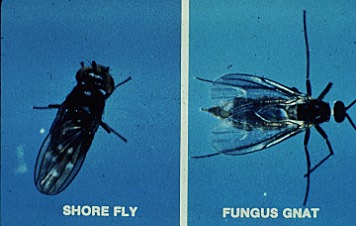|
|
Back to Pest Identification and Diagnosis
 |
| Fungus gnat and shore fly adults From: Ohio Floriculture |
| INTRODUCTION TO FLIES |
|
Fungus gnats and shore flies occur nearly everywhere that greenhouse plants are grown. The adults of both groups are mostly nuisance pests, but can carry around one or more important species of plant disease-causing agents. The fungus gnat has long antennae and legs, and the head is quite small in relation to the body. The shore fly adult resembles a small house fly (It is about the size of a fruit fly), the antennae are short, and the head is relatively large with red eyes. In addition, shore flies have small whitish spots on their wings.
Both insects can complete the egg to adult cycle in 25 to 30 days. Fungus gnat larvae are whitish, translucent with shiny black heads. They occur in the soil, or potting mix, and feed on fungi and healthy plant tissue. Shore fly larvae live in wet areas containing algae. Both adults and larvae feed on algae, not cultivated plants. Large numbers of shore flies can occur if there are algae growing on the potting mix, benches, plastic or glass, etc. Yellow sticky traps will catch adults of both insect groups. Horizontal traps, placed face up on the potting mix or bench, are effective. Once caught, it is important to distinguish between the two insect groups. Once again, fungus gnats on sticky traps are distinctly different from shore flies. The importance of identification is related to how one approaches control. Fungus gnats can be controlled with conventional or biorational insecticides, as well as biologically. Most applications are for control of larvae as drenches or heavy sprays. Conventional insecticides registered include chlorpyrifos (DuraGuard). Biorational products include azadirachtin (Azatin), Bacillus thuringiensis H-14 (Gnatrol), cyromazine (Citation), fenoxycarb (Precision), kinoprene (Enstar II) and diflubenzuron (Adept). Biological controls are insect-attacking nematodes (mostly Steinernema feltiae) and predatory mites in the genus Hypoaspis. Although there are a few insecticides (actually the insect growth regulators Citation, Precision and Adept) registered for shore fly control, as well as suggested biological controls, results have been unspectacular and inconsistent. This is probably because shore flies live in very wet areas and do not feed on plant roots. Cultural and physical controls will help. Avoid potting mixes that promote the growth of algae. Clean algae from benches, walls and floors. Do not have permanently wet areas in the greenhouse, especially containing fertilizer to promote algae. |
Back to Pest Identification and Diagnosis
 |
(C) Regents of the University of
Minnesota. All rights reserved. |
 |
 |